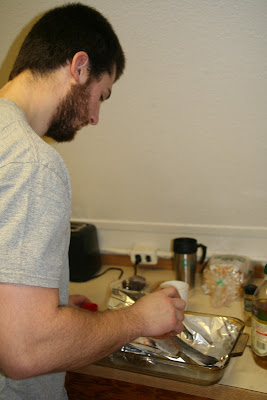Thursday night UMIAQ called a meeting of the Barrow Whaling
Captains’ Association to discuss and ask for permission for the upcoming
scientific research projects near Barrow.
Whaling season starts in early April, so cooperation between scientists
on the sea ice and the native community is of utmost importance. Kyle and I were honored to attend this
meeting and excited to learn about Iñupiat whaling, which is endangered due to
loss of Arctic sea ice. At the meeting
we met a humble whaling captain Herman Ahsoak who invited us into his home to
learn about whaling. To start learning
about Iñupiat whaling, we first visited the Iñupiat
Heritage Center,
a U.S. National Park Service site in Barrow.
 |
| Iñupiat
Heritage Center |
 |
| Painting at the Iñupiat
Heritage Center |
Friday night Kyle and I visited Herman
Ahsoak’s home, where he explained how his family and community hunts for whales
and how this way of life is in danger due to thinning sea ice. Subsistence hunting for bowhead whales is a
tradition in the Iñupiat Eskimo community.
Herman explained to us that the International Whaling Commission allows
Barrow Iñupiat to strike and harvest ~21 whales per year. There are ~57 whaling captains in Barrow,
with whaling crews consisting of families with children getting involved young
to pass along the cultural traditions.
 |
| Whaling crew preparing an umiaq (Photograph, Iñupiat
Heritage Center) |
For the spring whaling season, whaling crews break several
miles of trail manually using picks. The
trails are for snowmobiles from the coast to the lead (open “river” of water)
over the course of several weeks leading up to whaling season (April-May),
which is gradually getting earlier due to the loss of sea ice. The thinning sea ice is also making this
process even more dangerous for the whaling crews. The whalers then camp on the sea ice and
watch the water waiting for bowhead whales to surface. When a whale is spotted, the whalers climb
into an umiaq (seal-skin boat) and paddle quietly to approach the whale. These boats are made from bearded seal skins
and sew together in the weeks approaching whaling season using caribou sinew.
 |
| Herman shows us his umiaq, made from 5 bearded seal skins |
Once close to the whale, the harpooner throws a harpoon, aiming
just behind the blowhole. Herman showed
us his harpoon that was made of driftwood (see below).
An anchor hook penetrates into the whale is connected by line to a float
for tracking the whale once struck. Upon
striking the whale, a penetration trigger is pushed backward so that a bomb
(black powder encased in a brass shell) enters the whale, breaking a matchstick
and causing a weight to hit a pin on a 6 second fuse, igniting the black
powder. Following this initial hit, a
brass whaling gun can be used to shoot additional bombs if needed for a quick
kill.
Herman shows us his whaling gear
 |
| Kyle holding an empty whaling bomb |
 |
| Kyle holding a brass whaling gun |
 |
| Whaling anchor hook, harpoon, & bomb |
 |
| Kyle holding Herman's harpoon |
Before celebrating, the crew first says a solemn prayer of
thanks for the whale, which will feed the community. Motorboats from several whaling crews then
tow the whale to ice. Herman explained
to us that most harvested whales weigh ~40 tons and are ~40 ft in length (~1
ton per foot of whale). The community
then pulls the whale up onto the ice and butchers it. Afterward, the head is pushed into the sea to
feed life in the ocean. The whale skin
and blubber, known as maktak, is most liked by Herman’s family after fermenting
for several days.
 |
| Sketch, Iñupiat
Heritage Center |
 |
| Photograph of butchering a whale (Iñupiat
Heritage Center) |
“Sharing: Aviktuaqatigiigñiq
Don’t hold back when it comes to sharing. It is important to make sure everyone in the
community has a bit of the whale. None
is saved for the captain and crew when it is your first whale. – Jane Brower,
Barrow, 2002” (Iñupiat
Heritage Center)
 |
| Blanket toss (Photograph, Iñupiat
Heritage Center |
The community again celebrates the whaling harvest in June during
the blanket toss, when the sealskin from the successful whaling crews’ boats is
used to make something like a trampoline.
If the Barrow Iñupiat do not fill their quota in the springtime, then
motorboats can be used to hunt whales in the fall during their second
migration. Leftover whale following
initial celebrations is served in community churches at Thanksgiving and
Christmas.
 |
| Whale ear drum at Herman's house |
 |
| Walrus tusks at Herman's house |
While at Herman’s house, he showed us a National Geographic
video about the Iñupiat’s hunt for whales and this way of life is in danger due
to the changing climate. A clip of this
video can be seen at:


































